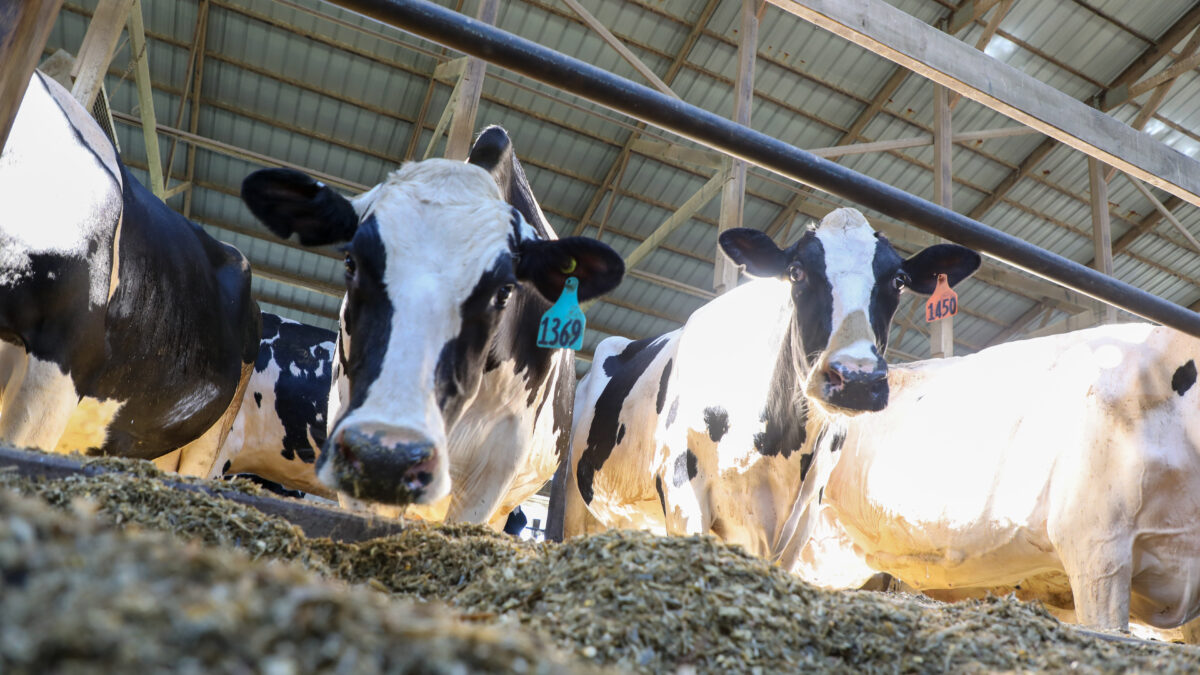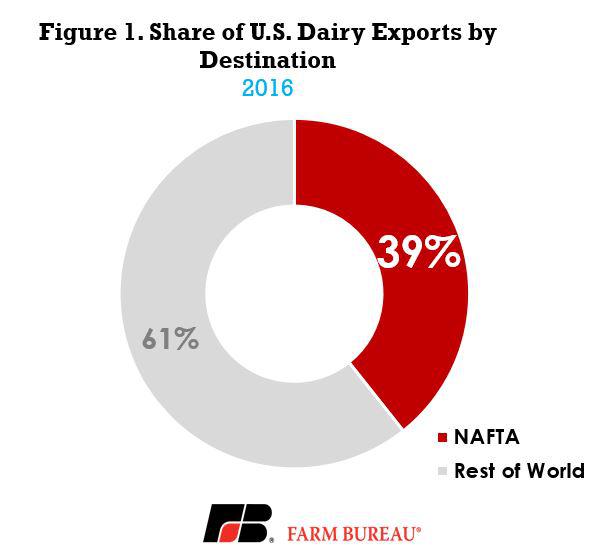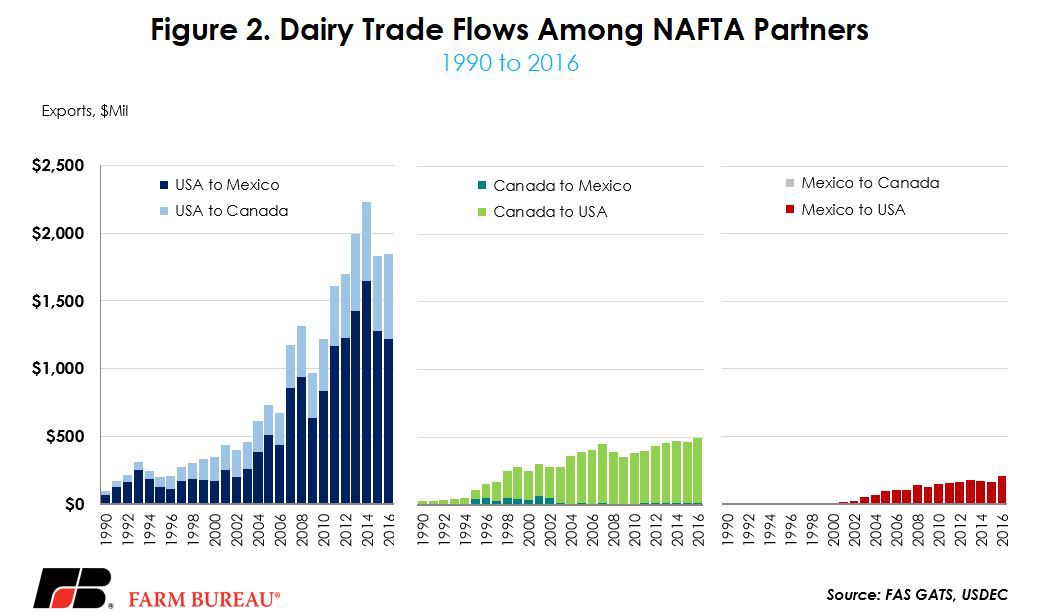U.S. Dairy and NAFTA

photo credit: Right Eye Digital, Used with Permission
Veronica Nigh
Senior Economist
Implications
The NAFTA agreement series continues our focus on commodities with a look at trade in dairy and dairy products. In 2016, nearly 40 percent of all U.S. dairy product exports made their way to our NAFTA partners, but recent moves by the governments of the United States, Mexico and Canada could lead to a change in the important Mexican and Canadian markets. A recent Market Intel article Canada Closes Door on U.S. Dairy Farmers reviews the recent concern in the dairy industry related to ultra-filtered milk.
NAFTA Has Been Good for Dairy
The importance of NAFTA to U.S. dairy farmers cannot be overstated. In recent years, dairy exports to Canada and Mexico averaged nearly $2 billion per year and accounted for 30 to 40 percent of all dairy exports. For comparison, in 2016 only 2 percent and 8 percent of U.S. dairy exports flowed to EU-28 and China respectively.

Since NAFTA’s implementation, dairy product exports to Canada and Mexico have totaled approximately $21 billion and increased by more than 500 percent from pre-NAFTA levels. The primary dairy products exported include non-fat dry milk, cheese, milk proteins, whey, butter and milkfat. The U.S. also imports a variety of dairy products from Canada and Mexico. These products include processed dairy foods, specialty cheeses, and butter valued at $691 million in 2016.
The net trade balance (exports minus imports) in dairy products with NAFTA members has grown from several hundred million dollars per year to more than $1 billion each year. The cumulative trade balance in dairy products stands at $12 billion in favor of U.S. dairy farmers and dairy product manufacturers, Figure 2.

It is on the back of NAFTA that the U.S. now exports nearly 15 percent of its annual milk production – equivalent to one day’s worth of milk production each week. Dairy industry economists will point out that the value of milk in the U.S. reached a record high in 2014 due to these export opportunities.
Could NAFTA Get Better for Dairy?
A new NAFTA could be even better for dairy. For example, under the Trans-Pacific Partnership, Mexico and Canada would have provided new market access for fluid milk, cheese, butter, powder and other dairy products. These gains would occur on top of market access already available and would have provided a boost to dairy farm revenue. In addition to new market access, Canada’s National Ingredients Strategy aimed at ultra-filtered milk could be addressed in a modernized NAFTA.
Certainly, there are other areas where NAFTA can be improved. Despite overall smooth trade between partners and adherence to existing NAFTA and WTO rules, a modernized NAFTA could serve as a model for future trade agreements the U.S. may enter. Agricultural related issues that weren’t negotiated a quarter century ago could be revisited in a modernized NAFTA. These non-tariff issues, which include biotechnology, sanitary and phytosanitary measures, and an intellectual property chapter on geographical indication, would establish more formal terms of trade in those regulatory areas.
What’s at Risk in a Modernized NAFTA?
As evidenced in Figure 2, for a variety of dairy products, the U.S. is the largest exporter to Mexico with market shares ranging from 75 to 100 percent for many of the high volume dairy imports. This may not always be the case.
Under TPP, Mexico would have provided new quota access and eliminated tariffs on a variety of dairy products. The gradual elimination of tariffs and the additional dedicated quota access provided by Mexico would have eroded U.S. market share for key dairy commodities.
While the U.S. withdrew from TPP, the remaining 11 TPP partners, including Mexico and Canada, have continued to discuss ways to make the economic benefits of TPP gains a reality. Especially critical to dairy trade, New Zealand, the world’s top dairy exporter, is also a TPP member. Additionally, the EU and Mexico recently launched negotiations to modernize their trade agreement. Enhancing access for the world’s No. 1 and No. 2 dairy exporters would make our top dairy market much more competitive.
Trade Is Important for Dairy
New trading opportunities are critically important to the U.S. dairy farmer’s milk check. Each year dairy exports represent at least $5 billion of the $36 billion farm-gate value of milk. Exports will soon play a larger role. USDA recently projected U.S. milk production would grow by 20 percent over the next decade to 260 billion pounds. That’s 50 billion additional pounds of milk that will need to be absorbed in the domestic and export channels. USDA forecasts an additional 16 billion pounds of use in the export market.
To reach this target, U.S. dairy exports need to grow by 42 percent and outpace the growth in both domestic consumption and U.S. milk production. Forgetting for a moment the strength of the dollar or world dairy product prices, substantially growing exports will be a tall task without new trade opportunities and modernizations to existing ones.
A version of this article, “Is it Time to Make NAFTA Great Again?,” first appeared in the March 10, 2017, issue of Hoard's Dairyman. Copyright 2017 by W.D. Hoard & Sons Company, Fort Atkinson, Wisconsin.